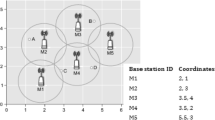Abstract
The problem of routing in mobile adhoc network has been approached in different methods. However, they suffer to achieve the required performance in quality of service. The mobile nodes spent most of the energy on routing because of cooperative transmission. To improve the performance of mobile adhoc network, an efficient LMHP routing algorithm is proposed in this paper. The source node discovers the route by sending LMHP route discovery (LMHP-RD) message to all its neighbors, identified in the neighbor discovery phase. The neighbors reply the LMHP-route request (RREQ) packet to the source node which contains power and displacement information about the intermediate nodes. The source node collects the information about the routes available along with power and displacement details. Using the identified information, the source node computes the transmission completeness weight for each route. Based on computed transmission completeness weight, the method selects a single route with maximum weight to perform data transmission. This method improves the throughput performance and increases the lifetime of the network. The proposed system is developed and simulated in NS2 and the performance has been analyzed based on three metrics Throughput, pocket delivery ratio and latency ratio. The simulated results show that the power consumption is relatively low in the proposed method, comparing the available techniques.








Similar content being viewed by others
References
Santhosh Kumar, B., Karthik, S., & Arunachalam, V. P. (2018). Upkeeping secrecy in information extraction using ‘k’ division graph based postulates. Cluster Computing. https://doi.org/10.1007/s10586-018-1705-2.
Kaur, K. D., & Bhardwaj, M. (2015). Effective energy constraint routing with on-demand routing protocols in MANET. American Journal of Networks and Communications, 4(2), 21–24.
Al-Fuqaha, A., Khan, B., Rayes, A., Guizani, M., Awwad, O., & Brahim, G. B. (2008). Opportunistic channel selection strategy for better QoS in cooperative networks with cognitive radio capabilities. IEEE Journal on Selected Areas in Communications, 26(1), 156–167.
Thirukrishna, J. T., Karthik, S., & Arunachalam, V. P. (2018). Revamp energy efficiency in homogeneous wireless sensor networks using optimised radio energy algorithm (OREA) and power aware distance source routing protocol. Future Generation Computer Systems, 81, 331–339.
Boukerche, A., Turgut, B., Aydin, N., Ahmad, M. Z., Bölöni, L., & Turgut, D. (2011). Routing protocols in ad hoc networks: A survey. Computer Networks, 55(13), 3032–3080.
Hajlaoui, R., Touil, S., & Achour, W. (2015). O-DSR: Optimized DSR routing protocol for mobile ad hoc network. International Journal of Wireless & Mobile Networks (IJWMN). https://doi.org/10.5121/ijwmn.2015.7403.
Clementi, A. E. F., Pasquale, F., & Silvestri, R. (2009). MANETS: High mobility can make up for low transmission power. In International colloquium on automata, languages and programming, ICALP 2009, Vol. 5556. Berlin: Springer.
Palaniappan, S., & Chellan, K. (2015). Energy-efficient stable routing using QoS monitoring agents in MANET. EURASIP Journal on Wireless Communications and Networking. https://doi.org/10.1186/s13638-014-0234-9.
Sargolzaey, H., Ali, B. M., & Khatun, S. (2011). A cross layer metric for discovering reliable routes in mobile ad hoc networks. Berlin: Springer.
Bojd, E. A. (2015). A new reactive routing algorithm to improve capacity and average end-to-end delay in MANETs. Arabian Journal for Science and Engineering, 40(2), 487–499.
Prabha, R., & Ramaraj, N. (2015). An improved multipath MANET routing using link estimation and swarm intelligence. EURASIP Journal on Wireless Communications and Networking. https://doi.org/10.1186/s13638-015-0385-3.
Yang, X.-S. (2013). Bat algorithm: Literature review and applications. International Journal of Bio-Inspired Computation, 5(3), 141–149.
Cai, J., & Liu, K. (2011). An improved AOMDV routing protocol based on prediction of link stability. Paper presented at the fourth international conference on machine vision (ICMV 11). International Society for Optics and Photonics, Singapore, p. 83500.
Singh, V. R., & Gupta, S. (2014). EE-AODV: energy efficient AODV routing protocol by optimizing route selection process. IJRCCT, 3(1), 158–163.
Abbas, N. I., Ilkan, M., & Ozen, E. (2015). Fuzzy approach to improving route stability of the AODV routing protocol. EURASIP Journal on Wireless Communications and Networking, 2015, 236.
Hundal, G. S., Gupta, S. K., & Bedi, R. (2014). Adaptive approach to find a stable path between nodes in MANET. International Journal of Current Engineering and Technology, 4(4), 2898–2901.
Robinson, Y. H., & Rajaram, M. (2015). Energy-aware multipath routing scheme based on particle swarm optimization in mobile ad hoc networks. The Scientific World Journal, 2015. Article ID 284276, 9 pages.
Yildiz, A. R., & Solanki, K. N. (2012). Multi-objective optimization of vehicle crashworthiness using a new particle swarm based approach. The International Journal of Advanced Manufacturing Technology, 59(1–4), 367–376.
Author information
Authors and Affiliations
Corresponding author
Additional information
Publisher's Note
Springer Nature remains neutral with regard to jurisdictional claims in published maps and institutional affiliations.
Rights and permissions
About this article
Cite this article
Arumugham, K., Chenniappan, V. Least Mobility High Power (LMHP) Dynamic Routing for QoS Development in Manet. Wireless Pers Commun 105, 355–368 (2019). https://doi.org/10.1007/s11277-018-6116-4
Published:
Issue Date:
DOI: https://doi.org/10.1007/s11277-018-6116-4




